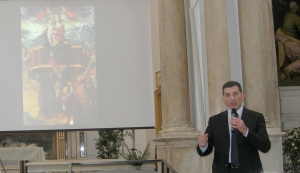Sofonisba lived a long prolific life. She began studying with Bernardino Campi around 1545. She died in 1625 and painted until at least 1610, probably longer. At the end of her life, she told Anthony van Dyke she wanted to keep painting in her last years, but her failing eyesight forced her to quit.
Still, Sofonisba painted for at least sixty-five years, probably more. She had her experimental early years, her Lombard portraiture years, her court years in Spain, and her long post-court period painting everything from royal portraits to Madonnas to miniatures. And yet, we are fairly certain of only 57 or so of her paintings, with some attributions disputed or in flux. See partial list of Sofonisba’s work.
There must be more. Even if she did just one piece of art work every year, she has a body of work out there of at least sixty-five pieces. But Sofi was prolific. She had to have done at least two a year. But two only? As prolific as she was, might she not have done at least three, four, five pieces a year? Five pieces a year from someone who sketched (drawing of crying baby to Michelangelo) and painted all the influential people she met (the King of Spain, Francesco de Medici, the Archduchess of the Spanish Netherlands), varying her styles all along (self portraits, portraits within portraits, landscapes, miniatures, massive Madonnas, mannerist holy families).
At five a year, Sofonisba might have a body of work out there, as yet to be discovered, somewhere along the lines of 325 pieces! It’s possible. We know of Titian’s volume of work. If Sofonisba’s life story tells us one thing, it’s that her gender never stopped her from painting.

I am a big fan of Alfio Nicotra, originally of Paternò Sicily, the town of Sofonsiba’s first marriage. Dr. Nocotra discovered Sofonisba’s Madonna dell’Itria and attributed it to her in 1995. Scholars disputed the attribution because it was so stylistically experimental compared to her accepted body of work, but Dr. Nicotra persevered. Then, in 2002, he found a document proving Sofonisba’s authorship, a letter in which she donated the painting to the local Franciscans of Paterno, dated June 25, 1579. Dr. Nicotra never doubted the range of Sofonisba’s work, in style and volume.
Dr. Nicotra has attributed a dozen or so paintings to Sofonisba, including 1580 portraits of Francesco de Medici and his daughter Eleanora, the future Duchess of Mantua and patroness-to-be of Peter Paul Rubens.
Today, Sofonisba’s family continues the search for her work, with Dr. Ferrante Anguissola hosting Progetto Sofonisba to help promote and discover Sofonisba’s legacy.
There’s certainly a movement going on to discover Sofonsiba’s life and work. Museum guides and survey art history books in the 80s, 90s or 2000s rarely mentioned Sofonisba. Not so today. I was in San Francisco’s De Young museum yesterday and picked up a book on Velazquez by Javier Portus and went to the index. There she was, Anguissola, Sofonisba, at least in a note.
In Rome, at the Doria Pamphili Gallery, Sofonisba’s Portrait of Husband and Wife used to be displayed on a main gallery wall along with the other great Renaissance masterpieces the Doria Pamphili owns. Today, that piece is in the prince’s private apartments, peeking out of a window where the public can just barely spy it. Of all the masterpieces the family could choose to covet, they picked Sofonisba’s. It only proves her growing allure. I hope the movement to discover Sofonisba can unearth a few hundred more pieces for us to study and enjoy.
2 responses to “Sofonisba Lives On”
What a great article. I can’t wait to read the book.
LikeLike
Thanks, Julienne. I’m looking forward to getting it published. I’ll be putting up more blogs this summer. Please check back.
LikeLike